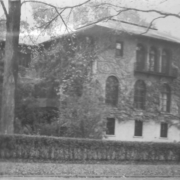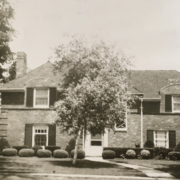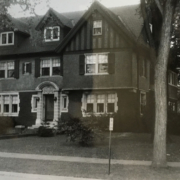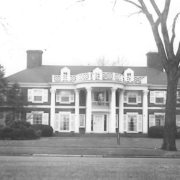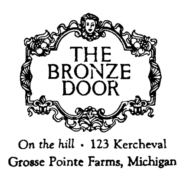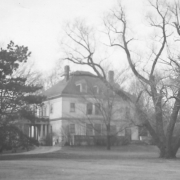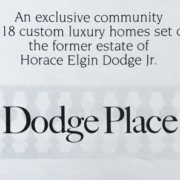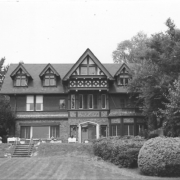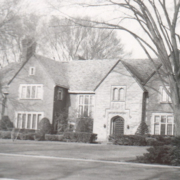Historical Architecture of Grosse Pointe – 910 Edgemont Park
Last week we concluded our series on architect Leonard B. Willeke with a look at the speculative homes he created in the community from the 1920’s – through to the 1940’s. Willeke’s spec homes varied in size and many were grand affairs. He was one of the most prolific architects in this sector, during a period of 20 years he built over 10 spec homes in Grosse Pointe.
This week we present the story of one of Grosse Pointe’s lost estates – 910 Edgemont – a once beautiful Italian Renaissance Revival style home completed in 1925, allegedly for Walter & Edith Scotten. Our files list the architect as George V. Pottle; however, this has not been verified by blueprints. George Pottle was associated, amongst other things, with creating industrial buildings, movie theaters, and fine residences throughout Metro Detroit. It appears possibly his only other recognized project in Grosse Pointe was 812 Whittier, completed in 1927.
The road of Edgemont Park is quite beautiful. A small unassuming dead-end street, it is located between Ellair Place and Park Lane in Grosse Pointe Park. The secluded road is lined with an abundance of trees, so much so that many of the homes are almost hidden from view. At the end of the street is a small lakefront park, each family has a key, providing residents with a place to call their own. The road is home to a handful of residences and there is some superb architecture on display created by several skilled designers. The houses are somewhat unique to the street, the styles range from French Colonial, English Tudor, through to several excellent examples of Italian Renaissance Revival design. Many of the homes were constructed during the 1920’s and were created by some of Detroit’s more prominent architects – Louis Kamper, Hugh T. Keyes, Clair W. Ditchy, along with two homes by Marcus Burrowes. You can read the full story of Edgemont Park by clicking here.

910 Edgemont Park was described as a unique and elegant 27-room Venetian palazzo style home (palazzo refers to an architectural style of the 19th and 20th centuries based upon the palazzi (palaces) built by wealthy families of the Italian Renaissance – source Wikipedia). lt was located on a ¾ acre double lot.
The 9,500 sq ft house was constructed from solid masonry with a stucco finish, Cyprus trim, with a slate roof and leaded glass windows. The interior was just as opulent with rare woods, marble, oak and mosaic floors, 20 ft ceilings, and Pewabic tile. Many of the walls and ceilings were said to be covered with canvas. The property once had nine bedrooms, seven bathrooms, and five fireplaces (located in the master bedroom, bridal suite bedroom, subterranean games room, the main living room, and the library). Based on a listing from May 1979, we understand (from our files) the large 25’ x 25’ sq ft foyer had a marble floor and a winding stairwell. Unusually it appears many of the main “family rooms” were located on the second floor. The first-floor space was the location for the 20’ x 36’ sq ft subterranean games room, a 3-bedroom apartment, and the laundry room. The second floor contained the 20’ x 36’ sq ft main living room, with ash paneling and parquet floor; an elegant 30’ x 20’ sq ft dancing room with full parquet floor; a 20’ x 29’ sq ft dining room; a black walnut paneled 18’ x 14’ sq ft library; along with two back-to-back kitchens; and a 10’ x 18’ sq ft sunroom. The third floor featured a massive 44’ x 18’ sq ft master bedroom suite along with 4 additional bedrooms with the “bridal suite” bedroom having access to a private deck roof porch. The estate also included a circular drive with additional parking at the side and rear, and a 3-car heated garage that had attached service quarters with a full kitchen.
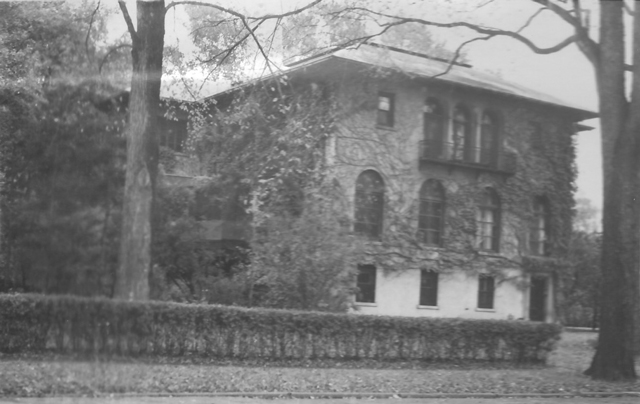
One of the earliest owners of 910 Edgemont Park (possibly the first owner), was Walter Scotten, president of the historic Tobacco firm Scotten, Dillion Company. Born in Detroit in 1876, he was the nephew of Daniel Scotten who, in 1856, founded the Scotten, Dillion Company which produced smoking and chewing tobacco. Warren Scotten graduated from the University of Michigan as a chemistry major. Aside from working for Scotten, Dillion Co., (for 60 years) where he was president of the firm for 20 years, he was also a former chairman of the board of the Fort Shelby Hostel, and a former director of the Detroit Trust Co. and the First National Bank. He married Edith Alaine Morton on July 14, 1908, and together they had three children, two daughters and a son. Walter Scotten passed March 10, 1957. Image courtesy of Detroit Free Press (May 11, 1957).
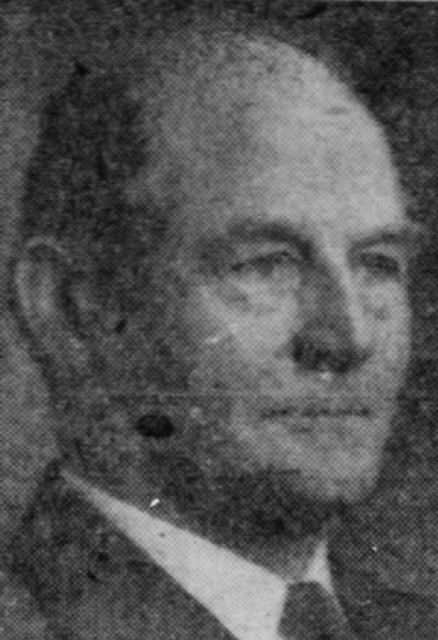
It appears the Scotten Estate owned 910 Edgemont Park until December 1961, when it was sold for $22,000 (around $221,000 today). However, it was originally listed in 1959, for $45,000 (around $466,000 today), which included an extra 100’ lot.
Post 1961, 910 Edgemont Park was sold several times. By the early 1990’s it is reported the property was in a poor state of repair. After being sold for one final time, allegedly for $22,000 (around $45,000 today) the once beautiful home was demolished in April 1995. The lot was subsequently split into two parcels and a house was built on each lot – 902 Edgemont Park (built in 1995) and 910 Edgemont Park (built in 1996).
The Mediterranean style homes constructed during the 1920’s in Grosse Pointe were incredibly beautiful. Such a shame that 910 Edgemont isn’t around to be part of the existing collection.
*Photos courtesy of the Higbie Maxon Agney archives unless stated.
** Research, information, and data sources are deemed reliable, but accuracy cannot be fully guaranteed.
Written by Katie Doelle
Copyright © 2023 Katie Doelle

